Corporate Social Responsibility in Business: MGMT 1102 Exam
VerifiedAdded on 2023/04/23
|7
|1788
|223
Essay
AI Summary
This essay provides a detailed analysis of corporate social responsibility (CSR), addressing key concepts such as 'cradle to grave' versus 'cradle to cradle' design, and offering an example of Carlsberg's transition to a circular process. It examines Wayne Visser's perspective on Walmart as a model for emulation in sustainability, highlighting Walmart's sustainability initiatives despite its primary objective of profit. The essay also defines glocality and its application to business, emphasizing the benefits of adapting global strategies to local conditions. The document concludes with references to support the arguments and examples presented. Desklib offers a wealth of similar resources for students seeking academic support.
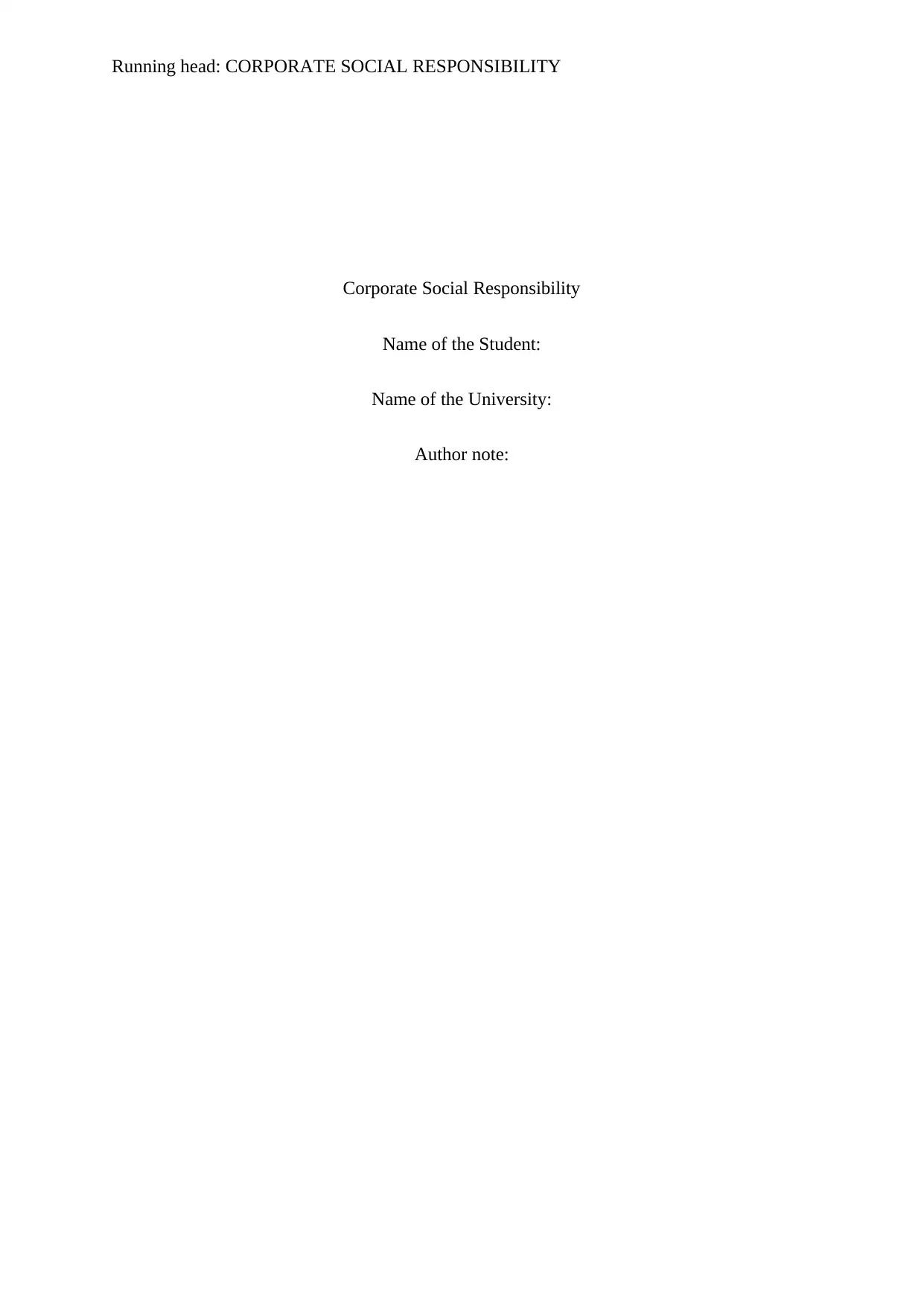
Running head: CORPORATE SOCIAL RESPONSIBILITY
Corporate Social Responsibility
Name of the Student:
Name of the University:
Author note:
Corporate Social Responsibility
Name of the Student:
Name of the University:
Author note:
Paraphrase This Document
Need a fresh take? Get an instant paraphrase of this document with our AI Paraphraser
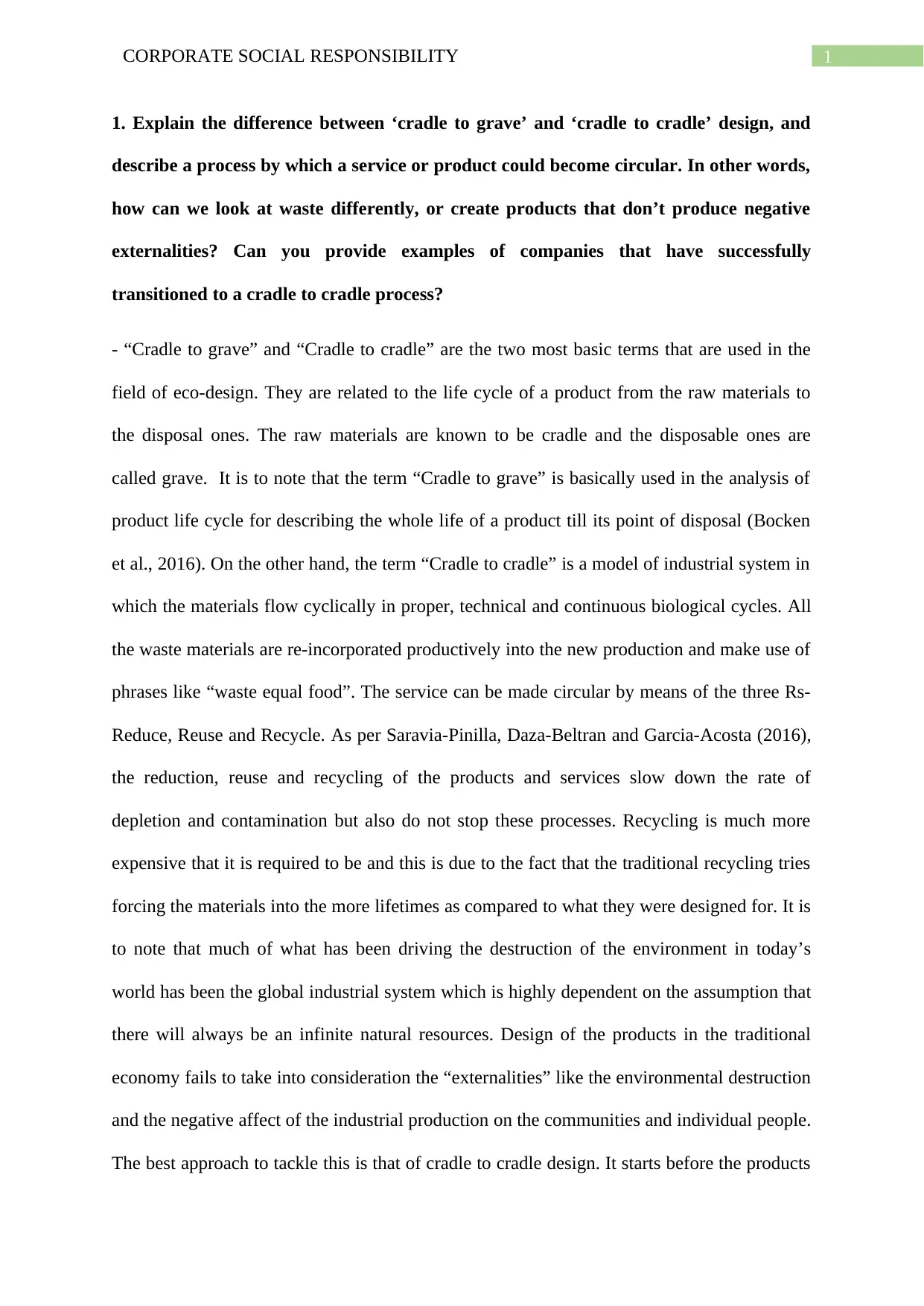
1CORPORATE SOCIAL RESPONSIBILITY
1. Explain the difference between ‘cradle to grave’ and ‘cradle to cradle’ design, and
describe a process by which a service or product could become circular. In other words,
how can we look at waste differently, or create products that don’t produce negative
externalities? Can you provide examples of companies that have successfully
transitioned to a cradle to cradle process?
- “Cradle to grave” and “Cradle to cradle” are the two most basic terms that are used in the
field of eco-design. They are related to the life cycle of a product from the raw materials to
the disposal ones. The raw materials are known to be cradle and the disposable ones are
called grave. It is to note that the term “Cradle to grave” is basically used in the analysis of
product life cycle for describing the whole life of a product till its point of disposal (Bocken
et al., 2016). On the other hand, the term “Cradle to cradle” is a model of industrial system in
which the materials flow cyclically in proper, technical and continuous biological cycles. All
the waste materials are re-incorporated productively into the new production and make use of
phrases like “waste equal food”. The service can be made circular by means of the three Rs-
Reduce, Reuse and Recycle. As per Saravia-Pinilla, Daza-Beltran and Garcia-Acosta (2016),
the reduction, reuse and recycling of the products and services slow down the rate of
depletion and contamination but also do not stop these processes. Recycling is much more
expensive that it is required to be and this is due to the fact that the traditional recycling tries
forcing the materials into the more lifetimes as compared to what they were designed for. It is
to note that much of what has been driving the destruction of the environment in today’s
world has been the global industrial system which is highly dependent on the assumption that
there will always be an infinite natural resources. Design of the products in the traditional
economy fails to take into consideration the “externalities” like the environmental destruction
and the negative affect of the industrial production on the communities and individual people.
The best approach to tackle this is that of cradle to cradle design. It starts before the products
1. Explain the difference between ‘cradle to grave’ and ‘cradle to cradle’ design, and
describe a process by which a service or product could become circular. In other words,
how can we look at waste differently, or create products that don’t produce negative
externalities? Can you provide examples of companies that have successfully
transitioned to a cradle to cradle process?
- “Cradle to grave” and “Cradle to cradle” are the two most basic terms that are used in the
field of eco-design. They are related to the life cycle of a product from the raw materials to
the disposal ones. The raw materials are known to be cradle and the disposable ones are
called grave. It is to note that the term “Cradle to grave” is basically used in the analysis of
product life cycle for describing the whole life of a product till its point of disposal (Bocken
et al., 2016). On the other hand, the term “Cradle to cradle” is a model of industrial system in
which the materials flow cyclically in proper, technical and continuous biological cycles. All
the waste materials are re-incorporated productively into the new production and make use of
phrases like “waste equal food”. The service can be made circular by means of the three Rs-
Reduce, Reuse and Recycle. As per Saravia-Pinilla, Daza-Beltran and Garcia-Acosta (2016),
the reduction, reuse and recycling of the products and services slow down the rate of
depletion and contamination but also do not stop these processes. Recycling is much more
expensive that it is required to be and this is due to the fact that the traditional recycling tries
forcing the materials into the more lifetimes as compared to what they were designed for. It is
to note that much of what has been driving the destruction of the environment in today’s
world has been the global industrial system which is highly dependent on the assumption that
there will always be an infinite natural resources. Design of the products in the traditional
economy fails to take into consideration the “externalities” like the environmental destruction
and the negative affect of the industrial production on the communities and individual people.
The best approach to tackle this is that of cradle to cradle design. It starts before the products
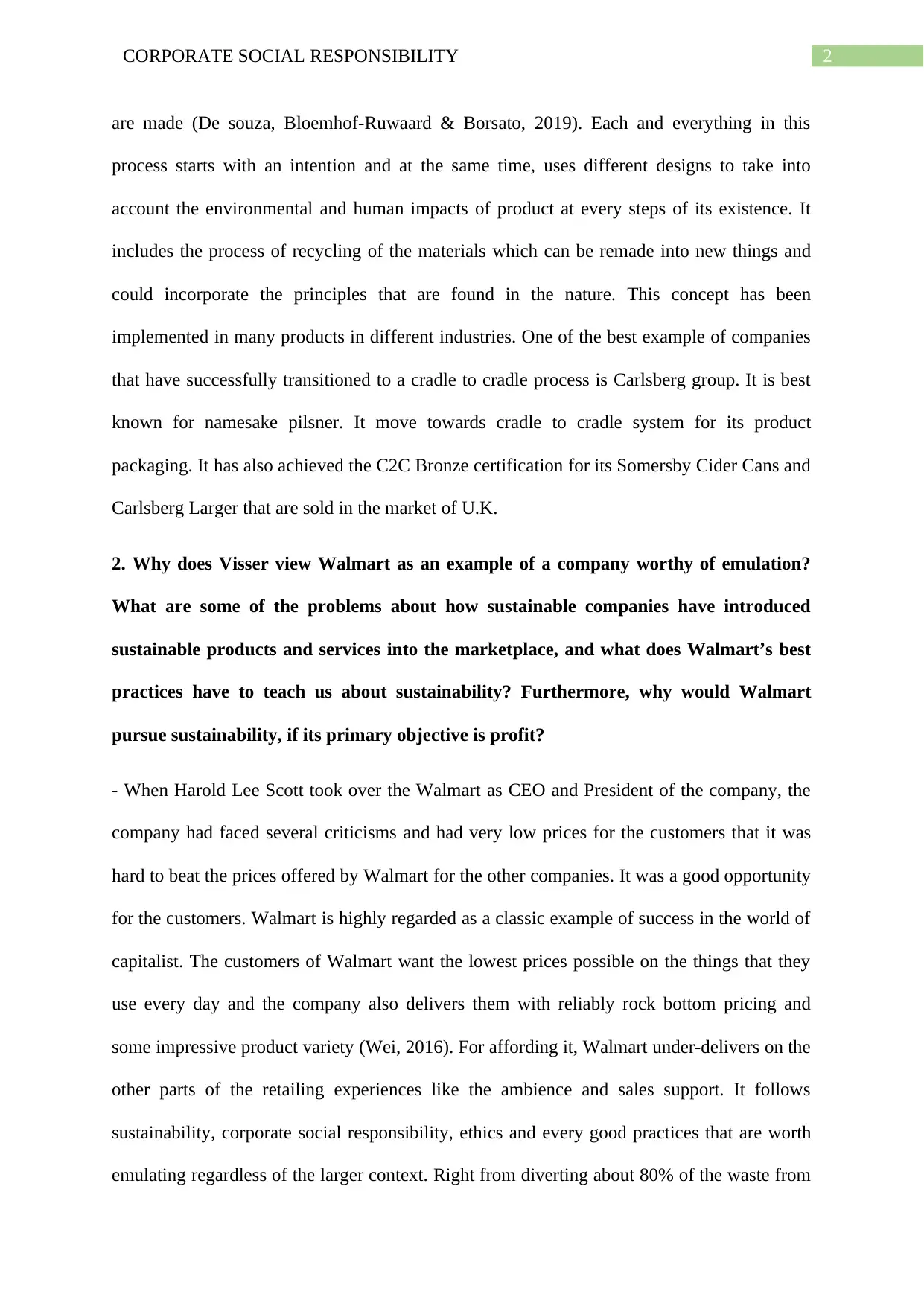
2CORPORATE SOCIAL RESPONSIBILITY
are made (De souza, Bloemhof-Ruwaard & Borsato, 2019). Each and everything in this
process starts with an intention and at the same time, uses different designs to take into
account the environmental and human impacts of product at every steps of its existence. It
includes the process of recycling of the materials which can be remade into new things and
could incorporate the principles that are found in the nature. This concept has been
implemented in many products in different industries. One of the best example of companies
that have successfully transitioned to a cradle to cradle process is Carlsberg group. It is best
known for namesake pilsner. It move towards cradle to cradle system for its product
packaging. It has also achieved the C2C Bronze certification for its Somersby Cider Cans and
Carlsberg Larger that are sold in the market of U.K.
2. Why does Visser view Walmart as an example of a company worthy of emulation?
What are some of the problems about how sustainable companies have introduced
sustainable products and services into the marketplace, and what does Walmart’s best
practices have to teach us about sustainability? Furthermore, why would Walmart
pursue sustainability, if its primary objective is profit?
- When Harold Lee Scott took over the Walmart as CEO and President of the company, the
company had faced several criticisms and had very low prices for the customers that it was
hard to beat the prices offered by Walmart for the other companies. It was a good opportunity
for the customers. Walmart is highly regarded as a classic example of success in the world of
capitalist. The customers of Walmart want the lowest prices possible on the things that they
use every day and the company also delivers them with reliably rock bottom pricing and
some impressive product variety (Wei, 2016). For affording it, Walmart under-delivers on the
other parts of the retailing experiences like the ambience and sales support. It follows
sustainability, corporate social responsibility, ethics and every good practices that are worth
emulating regardless of the larger context. Right from diverting about 80% of the waste from
are made (De souza, Bloemhof-Ruwaard & Borsato, 2019). Each and everything in this
process starts with an intention and at the same time, uses different designs to take into
account the environmental and human impacts of product at every steps of its existence. It
includes the process of recycling of the materials which can be remade into new things and
could incorporate the principles that are found in the nature. This concept has been
implemented in many products in different industries. One of the best example of companies
that have successfully transitioned to a cradle to cradle process is Carlsberg group. It is best
known for namesake pilsner. It move towards cradle to cradle system for its product
packaging. It has also achieved the C2C Bronze certification for its Somersby Cider Cans and
Carlsberg Larger that are sold in the market of U.K.
2. Why does Visser view Walmart as an example of a company worthy of emulation?
What are some of the problems about how sustainable companies have introduced
sustainable products and services into the marketplace, and what does Walmart’s best
practices have to teach us about sustainability? Furthermore, why would Walmart
pursue sustainability, if its primary objective is profit?
- When Harold Lee Scott took over the Walmart as CEO and President of the company, the
company had faced several criticisms and had very low prices for the customers that it was
hard to beat the prices offered by Walmart for the other companies. It was a good opportunity
for the customers. Walmart is highly regarded as a classic example of success in the world of
capitalist. The customers of Walmart want the lowest prices possible on the things that they
use every day and the company also delivers them with reliably rock bottom pricing and
some impressive product variety (Wei, 2016). For affording it, Walmart under-delivers on the
other parts of the retailing experiences like the ambience and sales support. It follows
sustainability, corporate social responsibility, ethics and every good practices that are worth
emulating regardless of the larger context. Right from diverting about 80% of the waste from
⊘ This is a preview!⊘
Do you want full access?
Subscribe today to unlock all pages.

Trusted by 1+ million students worldwide
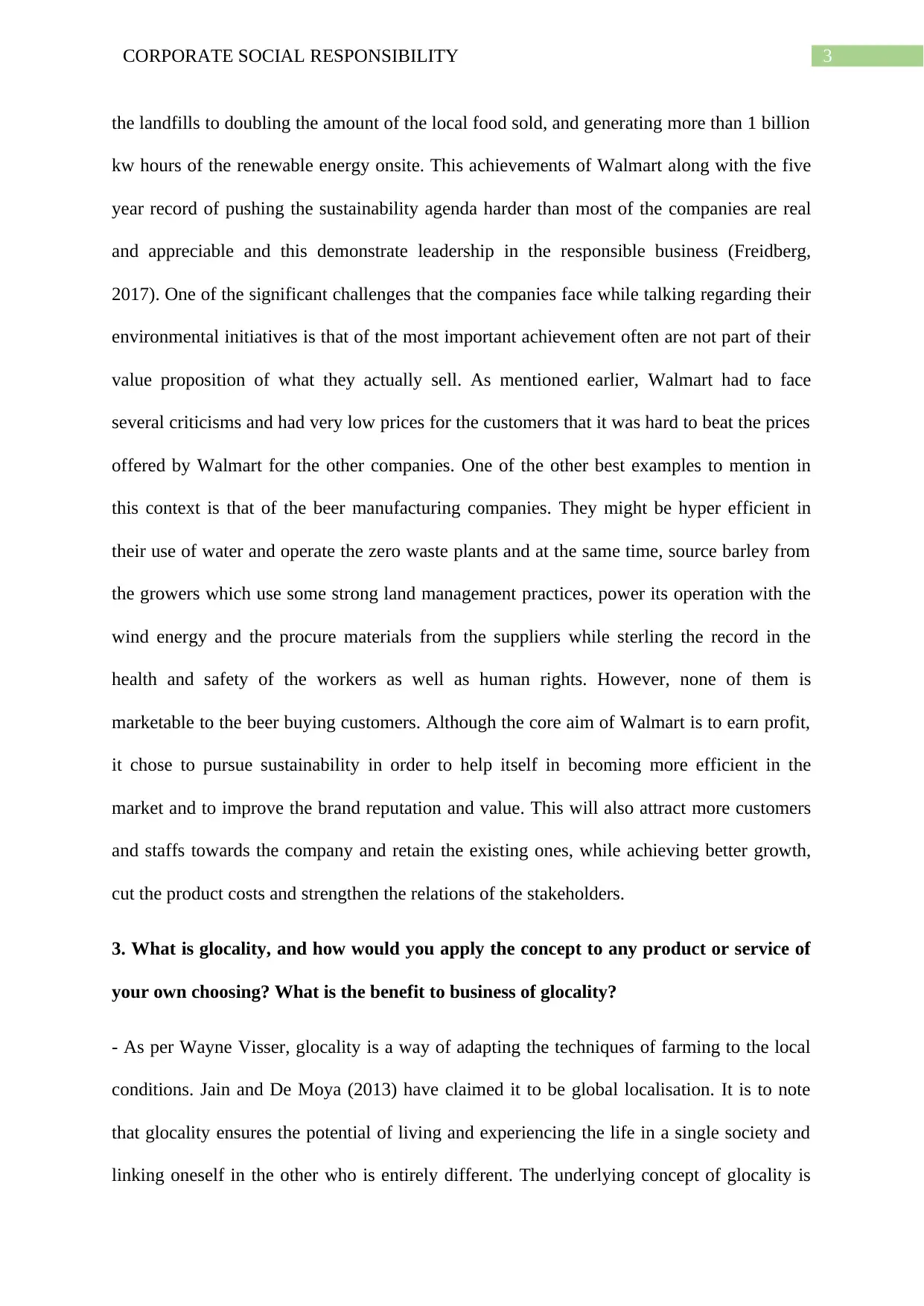
3CORPORATE SOCIAL RESPONSIBILITY
the landfills to doubling the amount of the local food sold, and generating more than 1 billion
kw hours of the renewable energy onsite. This achievements of Walmart along with the five
year record of pushing the sustainability agenda harder than most of the companies are real
and appreciable and this demonstrate leadership in the responsible business (Freidberg,
2017). One of the significant challenges that the companies face while talking regarding their
environmental initiatives is that of the most important achievement often are not part of their
value proposition of what they actually sell. As mentioned earlier, Walmart had to face
several criticisms and had very low prices for the customers that it was hard to beat the prices
offered by Walmart for the other companies. One of the other best examples to mention in
this context is that of the beer manufacturing companies. They might be hyper efficient in
their use of water and operate the zero waste plants and at the same time, source barley from
the growers which use some strong land management practices, power its operation with the
wind energy and the procure materials from the suppliers while sterling the record in the
health and safety of the workers as well as human rights. However, none of them is
marketable to the beer buying customers. Although the core aim of Walmart is to earn profit,
it chose to pursue sustainability in order to help itself in becoming more efficient in the
market and to improve the brand reputation and value. This will also attract more customers
and staffs towards the company and retain the existing ones, while achieving better growth,
cut the product costs and strengthen the relations of the stakeholders.
3. What is glocality, and how would you apply the concept to any product or service of
your own choosing? What is the benefit to business of glocality?
- As per Wayne Visser, glocality is a way of adapting the techniques of farming to the local
conditions. Jain and De Moya (2013) have claimed it to be global localisation. It is to note
that glocality ensures the potential of living and experiencing the life in a single society and
linking oneself in the other who is entirely different. The underlying concept of glocality is
the landfills to doubling the amount of the local food sold, and generating more than 1 billion
kw hours of the renewable energy onsite. This achievements of Walmart along with the five
year record of pushing the sustainability agenda harder than most of the companies are real
and appreciable and this demonstrate leadership in the responsible business (Freidberg,
2017). One of the significant challenges that the companies face while talking regarding their
environmental initiatives is that of the most important achievement often are not part of their
value proposition of what they actually sell. As mentioned earlier, Walmart had to face
several criticisms and had very low prices for the customers that it was hard to beat the prices
offered by Walmart for the other companies. One of the other best examples to mention in
this context is that of the beer manufacturing companies. They might be hyper efficient in
their use of water and operate the zero waste plants and at the same time, source barley from
the growers which use some strong land management practices, power its operation with the
wind energy and the procure materials from the suppliers while sterling the record in the
health and safety of the workers as well as human rights. However, none of them is
marketable to the beer buying customers. Although the core aim of Walmart is to earn profit,
it chose to pursue sustainability in order to help itself in becoming more efficient in the
market and to improve the brand reputation and value. This will also attract more customers
and staffs towards the company and retain the existing ones, while achieving better growth,
cut the product costs and strengthen the relations of the stakeholders.
3. What is glocality, and how would you apply the concept to any product or service of
your own choosing? What is the benefit to business of glocality?
- As per Wayne Visser, glocality is a way of adapting the techniques of farming to the local
conditions. Jain and De Moya (2013) have claimed it to be global localisation. It is to note
that glocality ensures the potential of living and experiencing the life in a single society and
linking oneself in the other who is entirely different. The underlying concept of glocality is
Paraphrase This Document
Need a fresh take? Get an instant paraphrase of this document with our AI Paraphraser
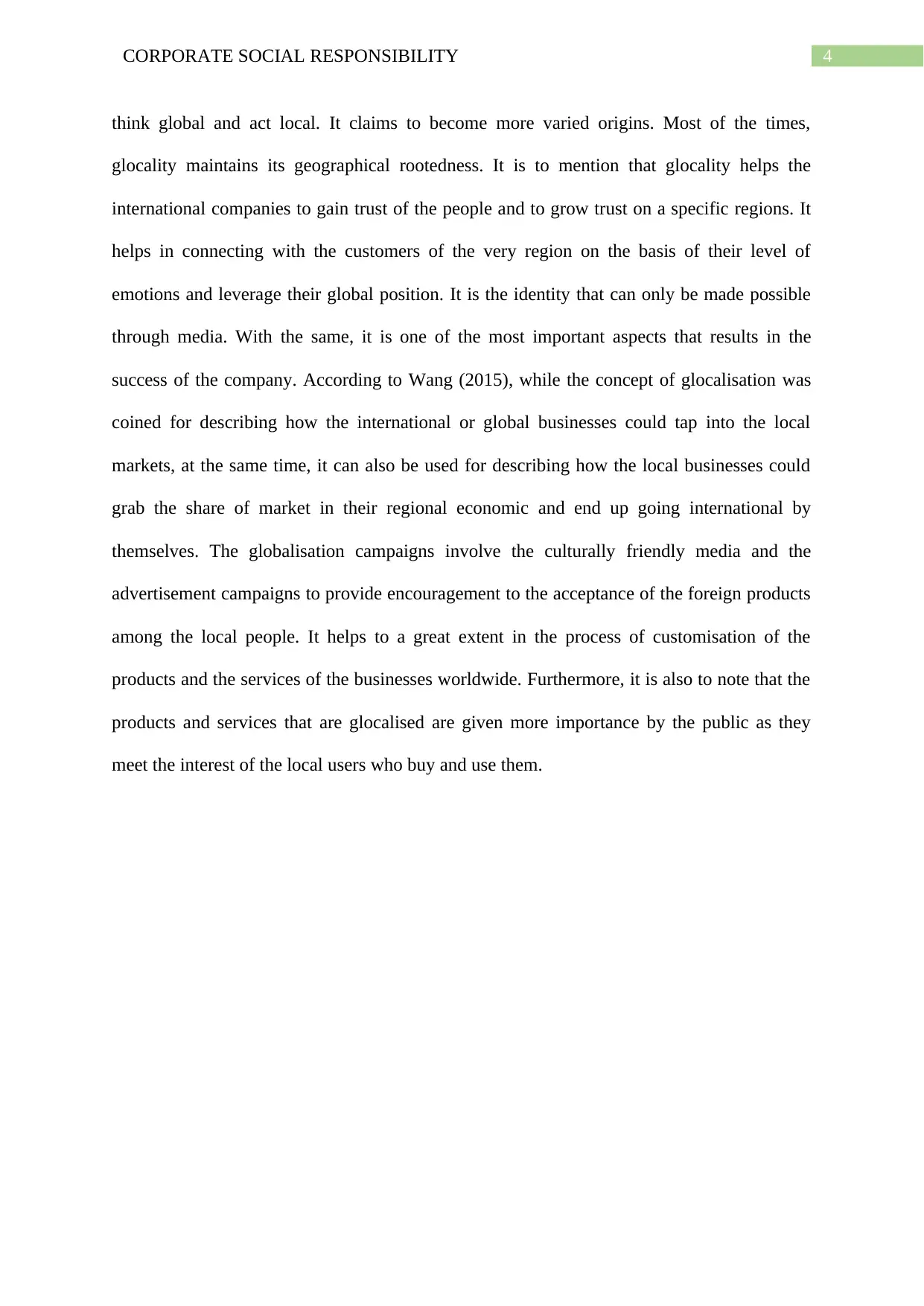
4CORPORATE SOCIAL RESPONSIBILITY
think global and act local. It claims to become more varied origins. Most of the times,
glocality maintains its geographical rootedness. It is to mention that glocality helps the
international companies to gain trust of the people and to grow trust on a specific regions. It
helps in connecting with the customers of the very region on the basis of their level of
emotions and leverage their global position. It is the identity that can only be made possible
through media. With the same, it is one of the most important aspects that results in the
success of the company. According to Wang (2015), while the concept of glocalisation was
coined for describing how the international or global businesses could tap into the local
markets, at the same time, it can also be used for describing how the local businesses could
grab the share of market in their regional economic and end up going international by
themselves. The globalisation campaigns involve the culturally friendly media and the
advertisement campaigns to provide encouragement to the acceptance of the foreign products
among the local people. It helps to a great extent in the process of customisation of the
products and the services of the businesses worldwide. Furthermore, it is also to note that the
products and services that are glocalised are given more importance by the public as they
meet the interest of the local users who buy and use them.
think global and act local. It claims to become more varied origins. Most of the times,
glocality maintains its geographical rootedness. It is to mention that glocality helps the
international companies to gain trust of the people and to grow trust on a specific regions. It
helps in connecting with the customers of the very region on the basis of their level of
emotions and leverage their global position. It is the identity that can only be made possible
through media. With the same, it is one of the most important aspects that results in the
success of the company. According to Wang (2015), while the concept of glocalisation was
coined for describing how the international or global businesses could tap into the local
markets, at the same time, it can also be used for describing how the local businesses could
grab the share of market in their regional economic and end up going international by
themselves. The globalisation campaigns involve the culturally friendly media and the
advertisement campaigns to provide encouragement to the acceptance of the foreign products
among the local people. It helps to a great extent in the process of customisation of the
products and the services of the businesses worldwide. Furthermore, it is also to note that the
products and services that are glocalised are given more importance by the public as they
meet the interest of the local users who buy and use them.
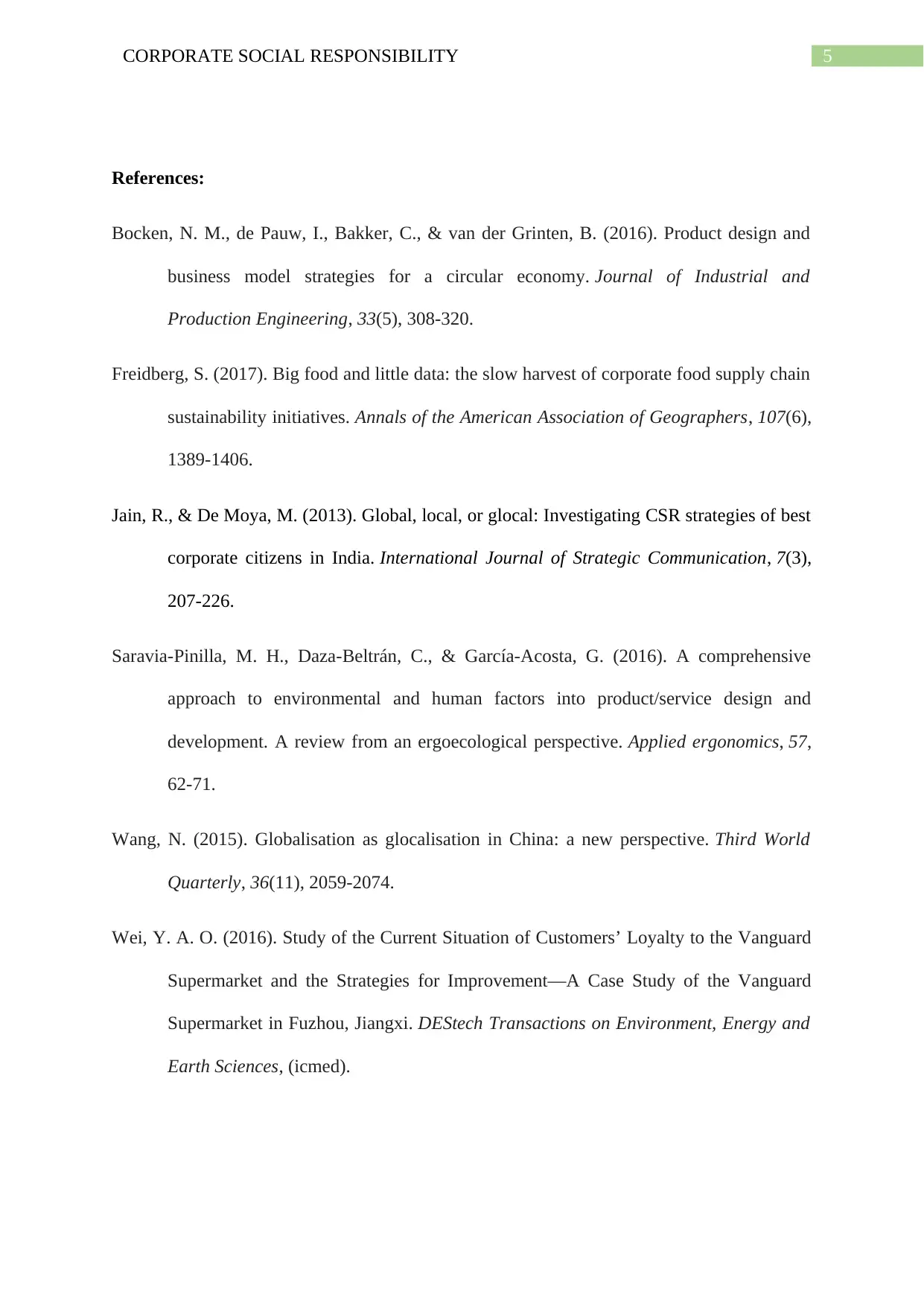
5CORPORATE SOCIAL RESPONSIBILITY
References:
Bocken, N. M., de Pauw, I., Bakker, C., & van der Grinten, B. (2016). Product design and
business model strategies for a circular economy. Journal of Industrial and
Production Engineering, 33(5), 308-320.
Freidberg, S. (2017). Big food and little data: the slow harvest of corporate food supply chain
sustainability initiatives. Annals of the American Association of Geographers, 107(6),
1389-1406.
Jain, R., & De Moya, M. (2013). Global, local, or glocal: Investigating CSR strategies of best
corporate citizens in India. International Journal of Strategic Communication, 7(3),
207-226.
Saravia-Pinilla, M. H., Daza-Beltrán, C., & García-Acosta, G. (2016). A comprehensive
approach to environmental and human factors into product/service design and
development. A review from an ergoecological perspective. Applied ergonomics, 57,
62-71.
Wang, N. (2015). Globalisation as glocalisation in China: a new perspective. Third World
Quarterly, 36(11), 2059-2074.
Wei, Y. A. O. (2016). Study of the Current Situation of Customers’ Loyalty to the Vanguard
Supermarket and the Strategies for Improvement—A Case Study of the Vanguard
Supermarket in Fuzhou, Jiangxi. DEStech Transactions on Environment, Energy and
Earth Sciences, (icmed).
References:
Bocken, N. M., de Pauw, I., Bakker, C., & van der Grinten, B. (2016). Product design and
business model strategies for a circular economy. Journal of Industrial and
Production Engineering, 33(5), 308-320.
Freidberg, S. (2017). Big food and little data: the slow harvest of corporate food supply chain
sustainability initiatives. Annals of the American Association of Geographers, 107(6),
1389-1406.
Jain, R., & De Moya, M. (2013). Global, local, or glocal: Investigating CSR strategies of best
corporate citizens in India. International Journal of Strategic Communication, 7(3),
207-226.
Saravia-Pinilla, M. H., Daza-Beltrán, C., & García-Acosta, G. (2016). A comprehensive
approach to environmental and human factors into product/service design and
development. A review from an ergoecological perspective. Applied ergonomics, 57,
62-71.
Wang, N. (2015). Globalisation as glocalisation in China: a new perspective. Third World
Quarterly, 36(11), 2059-2074.
Wei, Y. A. O. (2016). Study of the Current Situation of Customers’ Loyalty to the Vanguard
Supermarket and the Strategies for Improvement—A Case Study of the Vanguard
Supermarket in Fuzhou, Jiangxi. DEStech Transactions on Environment, Energy and
Earth Sciences, (icmed).
⊘ This is a preview!⊘
Do you want full access?
Subscribe today to unlock all pages.

Trusted by 1+ million students worldwide

6CORPORATE SOCIAL RESPONSIBILITY
1 out of 7
Related Documents
Your All-in-One AI-Powered Toolkit for Academic Success.
+13062052269
info@desklib.com
Available 24*7 on WhatsApp / Email
![[object Object]](/_next/static/media/star-bottom.7253800d.svg)
Unlock your academic potential
Copyright © 2020–2025 A2Z Services. All Rights Reserved. Developed and managed by ZUCOL.





